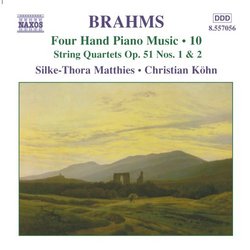| All Artists: Johannes Brahms, Christian Kohn, Silke-Thora Matthies Title: Brahms: Four Hand Piano Music, Vol. 10 Members Wishing: 0 Total Copies: 0 Label: Naxos Release Date: 2/17/2004 Genre: Classical Styles: Chamber Music, Historical Periods, Classical (c.1770-1830) Number of Discs: 1 SwapaCD Credits: 1 UPC: 747313205622 |
Search - Johannes Brahms, Christian Kohn, Silke-Thora Matthies :: Brahms: Four Hand Piano Music, Vol. 10
 | Johannes Brahms, Christian Kohn, Silke-Thora Matthies Brahms: Four Hand Piano Music, Vol. 10 Genre: Classical
|
Larger Image |
CD Details |
CD ReviewsVolume 10 in an Absolutely Superb Brahms Four-Hand Series J Scott Morrison | Middlebury VT, USA | 03/18/2004 (5 out of 5 stars) "Perhaps because I was a pianist, not a string player, I've been a huge fan of this continuing series of recordings of Brahms music arranged by the composer for four-hands at one piano featuring the piano duet team of Silke-Thora Matthies and Christian Kohn. (But I am not uniformly a fan of piano transcriptions: my enjoyment did not extend to a recent Naxos release of Stravinsky's 'Firebird' in the composer's own transcription for solo piano.) The only clunker up to now, as far as I'm concerned, was the 'German Requiem,' primarily because one really does miss the vocal soloists and choir. But I was a little bit leery about how it would go when this series reached Brahms's chamber music - up to now it's been arrangements of orchestral music in the series - but I needn't have worried. Indeed, I think this release, number ten in the series, may be the best yet.This CD contains the four-hand arrangements of the two Opus 51 String Quartets. Not having seen the scores for the piano duet arrangements I had wondered if Brahms added to what is essentially a four-voice texture. After hearing the recording I can assert that he added very little except for some octave doublings in the bass to strengthen the texture and some tremolos in the upper voices in order to convey what otherwise, on the piano, would be thunks rather than sustained string chords. Where they are added they contribute to the sound but they are hardly noticeable after one gets used to them. Brahms clearly knew what he was doing. What IS noticeable is how clear the piano-sound makes both the almost constant polyphony and frequent counterrhythms. In fact, in the first movement of the Second Quartet, which abounds in both of those features, one often loses, in string quartet performances, the gist of the counterpoint as well as rhythmic clarity due to the frequent and confusing voice-crossing four-against-three-against-two passages. Even very good quartets sometimes get mired in the congested texture and the metric complications. That doesn't happen here because of the slight percussive quality of piano tone. A viola-playing friend commented that this piano duet version would be helpful in coaching young quartets here, because it would help them hear what is supposed to come out in these passages. An interesting observation, I think. Finally I am astounded to find that I actually prefer the fourth movement of the Second Quartet in the piano-duet version. See what you think.I need not comment about the superb musicianship of this piano duet team. They are beyond praise. And since they seem now about to embark on the piano-duet versions of the chamber music I expect we can anticipate further enjoyment. So, if you've enjoyed this series up to now, prepare to be very pleased again and, with me, to anticipate future chamber music transcriptions. Thank you, Naxos, for this brilliant series so brilliantly conceived, performed and recorded.TT=69:02Scott Morrison"
|

 Track Listings (8) - Disc #1
Track Listings (8) - Disc #1